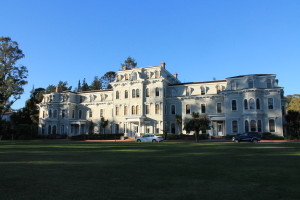The Golden Gate Bridge may be one of the first things that comes to mind when someone mentions San Francisco, but underneath its famous burnished arches sits a lesser known but equally majestic attraction.
Three stories high and over 150 years old, Fort Point is solidly built out of bricks and stone, with barracks of wood and glass. Archways line the open courtyard, leading to coves for the cannons. The fort was completed in 1861 as part of a military strategy to protect San Francisco from foreign attack during the time of the Gold Rush. It was strategically positioned to be a vital military base and was later used as a major deterrent for the Confederacy during the Civil War, but was never actually involved in any military exchange.
Today, Fort Point brushes up against the legs of the Golden Gate Bridge. It is situated just below a special arch that was added to the bridge, designed solely to preserve the National Historic Site.
With my friend and Bay Area native, Tate Bissinger, in the lead, my friends and I took a bus and then a Lyft to get to the fort on a recent Sunday afternoon. By mistake, our driver delivered us to the Fort Point Vista, the bluff above the fort itself. To get to our correct destination, my friend led the way down a trail to the fort’s roof tier.
From the roof facing the Bay, the afternoon sun sparkled off the ocean to my left, turning the bridge above us into a shining orange-gold. In front of me, the lush green hillsides of the Golden Gate National Recreation Area smiled at me, and to my right the rest of the bay opened up. Boats could be seen from the roof, as well as kitesurfers and windsurfers riding the work of the waves and the wind. Far in the distance, the dome of the Palace of Fine Arts Theatre winked, and the outline of the Oakland Hills stood on the horizon.
According to their website, up to 500 men were garrisoned at Fort Point during the Civil War, 1861- 1865. The bed bunks inside the barracks consisted of barely padded, thin pallets and coarse blankets. Having two men per bed, four men to a bunk, five bunks in the room, looked like a tight fit. Next to the water, at 15 feet above sea level, the rooms had a chill in the air to them, adding to their already peculiar scent and unsettling emptiness.

“It has lots of potential for creepiness and that’s part of why it’s awesome,” Bissinger said. “I like older style architecture because there’s a sense of it having a story.”
That hint of creepiness is a feeling that has long been associated with Fort Point. In 1958, director Alfred Hitchcock filmed part of his psychological thriller “Vertigo” near the fort, in which one of the lead characters, played by Kim Novak, jumps into the sea off the edge.
Walking out of the housing, we heard a call from the courtyard below.
“Cannon demonstration in five minutes!” yelled a staff member.
We clambered down the tall stairs, crossed the courtyard and settled on top of the benches that faced the front of a cannon. Our guide told stories of soldiers learning how to skip cannonballs–like skipping pebbles– in order to hit an enemy ship low enough to capsize it. In another story, for a holiday celebration, the soldiers sent a boat full of fireworks out into the bay. They wanted to light the fireworks by shooting a cannon and setting the filled boat ablaze. After hours of firing, the soldiers eventually had to send someone out to light it instead.
Though not an impressively large building, the Fort makes use of every inch it has: seven-foot-thick walls, and enough space to accommodate 141 cannons. Although the greatest number the building ever held was 102 cannons, the Fort was impressively equipped with enough cannons that could fire 24, 32 and 42 pound steel cannonballs, and “hotshot” furnaces that could heat up the cannonballs enough to set ships ablaze.
Though California was geographically removed from the Civil War, Fort Point still played a significant role in it. According to our guide, although California was democratic at its founding, San Francisco itself was divided almost half pro-union and half confederacy. Because of this, the cannons point in all directions, including the back side of the building that does not face the ocean. The Fort took precaution to aim cannons at the entrance of the building, the only way in and out, in case of a mutiny in the city.

After the Civil War, the Fort faced another adversary: possible demolition. The original plans for the Golden Gate Bridge did not leave room for Fort Point. It was only after Chief Engineer Joseph B. Strauss visited the Fort that the plans changed. He decided to make room for the Fort because he believe that “while the old fort has no military value now, it remains a fine example of the mason’s art.”
The fort’s location is picturesque as well as strategic. It stands today as a reminder of the Bay Area’s rich and complicated history. I recommend it as a place to take a breather, or to see the bridge without the traffic. Most importantly, visitors can revel in San Francisco from a different, quieter standpoint.
“It’s an interesting view of the Golden Gate Bridge,” Bissinger said. “Most people would go to the Marin side for the picture.”
Although its location’s historical significance is often overshadowed by its beauty, the value of the fort’s history is not lost on the people of the San Francisco area.
“When you live here, it’s important,” Bissinger said.



